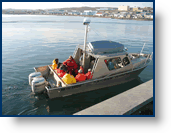Small Vessels
Safety is good business. Before you begin your voyage consider all the factors ( e.g. weather conditions, a certified crew and the right safety equipment). The first step to safety is adopting a safety culture (or safety management system). This means thinking safety at all times - planning and taking action to avoid potentially hazardous situations by being aware of your surroundings, ensuring the vessel is equipped and maintained for the intended voyage and knowing that the crew is trained and shares your concern for safe operations.
Your vessel
When was the last time you thought…
- Has my vessel been inspected, is the vessel certificate still valid?
- Are the repairs and maintenance up-to-date?
- Is the safety equipment checked on a regular basis?
- Did I check the weather and sea conditions before sailing and did I continue to monitor them throughout the voyage?
- Have I planned and prepared for the voyage?
- Is my crew trained and certified as required, and do they know and practice what to do in the event of any emergency?
Safety is a shared responsibility
In addition to the vessel owner or operator, many others contribute to safety:
- Boat builders design and construct vessels, appropriate for their intended use
- Service providers undertake the requisite maintenance and keep equipment, machinery, and systems running as designed
- Marine Safety Inspectors and marine surveyors provide expertise to verify the condition of vessels
- Crew and passengers bring safety questions and concerns to your attention
- Weather forecasters and Coast Guard Radio Stations provide critical safety information
We all play a role, but ultimately running a safe operation will be the best business decision you make. Protect your passengers, cargo and vessel; a professional mariner does not leave any of these considerations to chance. Whether part of a safety culture or a more formal safety management system, the responsible mariner always makes safety the highest priority.
